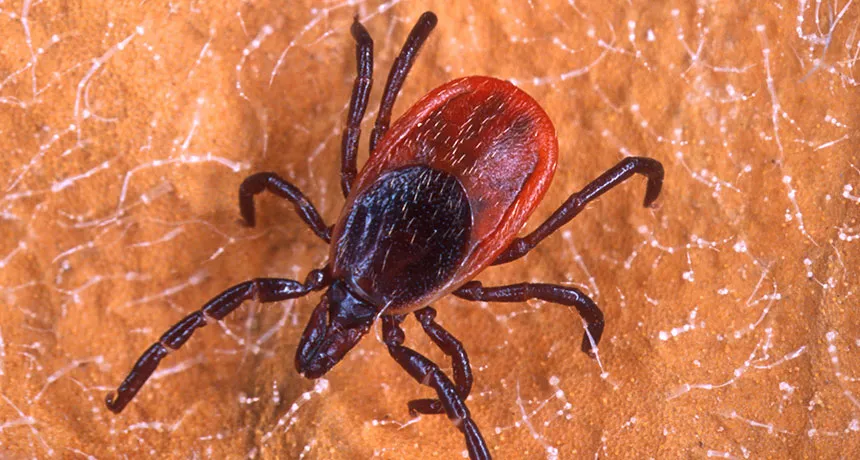Lyme and other tickborne diseases are on the rise in the U.S. Here’s what that means.
An infectious disease physician answers questions about the increase in cases

PERSISTANT PEST The bacteria that cause Lyme disease are spread by infected ticks, including the blacklegged tick Ixodes scapularis.
Scott Bauer, USDA Agricultural Research Service/Bugwood.org (CC BY 3.0)
- More than 2 years ago
There’s no sign that ticks are backing down.
A record high of 59,349 cases of tickborne diseases were reported in 2017 in the United States. That’s a 22 percent increase in cases — or roughly 11,000 more — than were reported in 2016, the Centers for Disease Control and Prevention announced on November 14.
Lyme disease accounted for most of the reported diseases, with nearly 43,000 cases in 2017, up from over 36,000 in 2016. There were increases in all six tick-related illnesses reported, though, including Rocky Mountain spotted fever. Because underreporting is common, experts expect the actual number of cases is higher than what the data show.
“The United States is not fully prepared to control these threats,” the agency said in statement.
The Tick-Borne Disease Working Group, set up by Congress in 2016 to address the threats that ticks pose, also released its first report on November 14, with input from public health officials, scientists, patients and clinicians. Science News discussed the findings with the working group’s chairman, infectious disease physician John Aucott, who is also the director of the Lyme Disease Research Center at Johns Hopkins School of Medicine.
His answers were edited for length and clarity.
SN: What’s the main takeaway of this new report?
Aucott: The key message is these tickborne diseases are serious, even potentially deadly, rapidly growing threats, and they affect hundreds of thousands of people.
So you [have to] combine prevention and accurate diagnoses and treatment.
SN: What are the gaps in prevention, diagnosis or treatment of these illnesses that you identified?
Aucott: A big component of prevention is the potential for future vaccine development [and] better ways to control ticks or control mice that harbor the infections. And there was an almost universal consensus that there needs to be improvement in diagnostic tests. We want to identify, diagnose and treat at the earliest stage, where the prognosis is the best.
We also need to fill in gaps in knowledge about how to better take care of the patients that don’t recover from their tickborne disease. [But] it’s hard to know what the best treatment is for the people that don’t get better until we understand the biology of what’s causing that ongoing illness.
One overriding theme of the report was education. We need to do better at educating physicians because they don’t always know what that Lyme bull’s-eye rash looks like. It’s usually just round and red without the Target department store bull’s-eye appearance to it. So that’s an example of educational things that are pretty simple to do, but at a state and local level and national level aren’t really happening as well as they could.
Steadfast rise
The number of reported tickborne illness in the United States has risen overall since 2004. But the actual number of cases is likely even higher since many cases go unreported, the CDC says.
Number of tickborne disease cases in the U.S. (2004–2017)


SN: What worries you the most about this increase in tickborne diseases?
Aucott: It’s really dramatic how many people are suffering from tickborne diseases. If you live in an area on the East Coast, everybody knows somebody who has problems with having had Lyme disease.
[The working group] heard from hundreds and hundreds of people that are living in silence in a lot of ways with this chronic illness that doesn’t kill them but really destroys the quality of their life. We don’t understand why this happens to some people. Until we understand that, it’s really hard to know how to help them. And that’s really what keeps me awake at night.
SN: Why are the number of cases of tickborne diseases increasing?
Aucott: It’s because the ticks are spreading. As the infected ticks spread geographically, more people are exposed to infected ticks, and you have more disease.
You have to have ticks in the same place as you have the animals that are reservoirs for the infections. The reservoir that carries the bacteria that cause Lyme disease, for example, are small animals like mice. So you have the mice that carry the bacteria, you have the ticks that spread the bacteria from mouse to mouse and then from mouse to humans. Then you add in the deer, which are the major food source for adult ticks. It’s bringing those all together.
The environmental geography of the United States has changed in a way to make that all very possible. We went from an agricultural economy, where all the land was clear-cut and there were no forests, [to] forests returning. These fragmented forests support that ecological niche for all those things to live together.
SN: What’s the message for those worried about tick exposure outdoors?
Aucott: We do lots of things that are way riskier than hiking in the woods. Way more people die every year driving their car on the Baltimore beltway, but we don’t stop driving our car. We just wear seat belts, we have airbags, we don’t text while we drive.
We want to apply the same precautions to hiking in the woods that we would do to driving our car. I’m a huge outdoorsman, but I always wear permethrin-treated clothing. I always wear long pants, even though it’s 95° F in Baltimore.
SN: Are there indications that cases will continue to rise?
Aucott: The rise of tickborne disease has been upward for the last 20 years. And there’s no indication at all that it’s going to slow down. New territory is being inhabited by infected ticks, and there’s really no barrier to that continuing to happen across large parts of the middle of the country in areas like Ohio and Tennessee and Kentucky [where tickborne diseases haven’t historically been reported].







